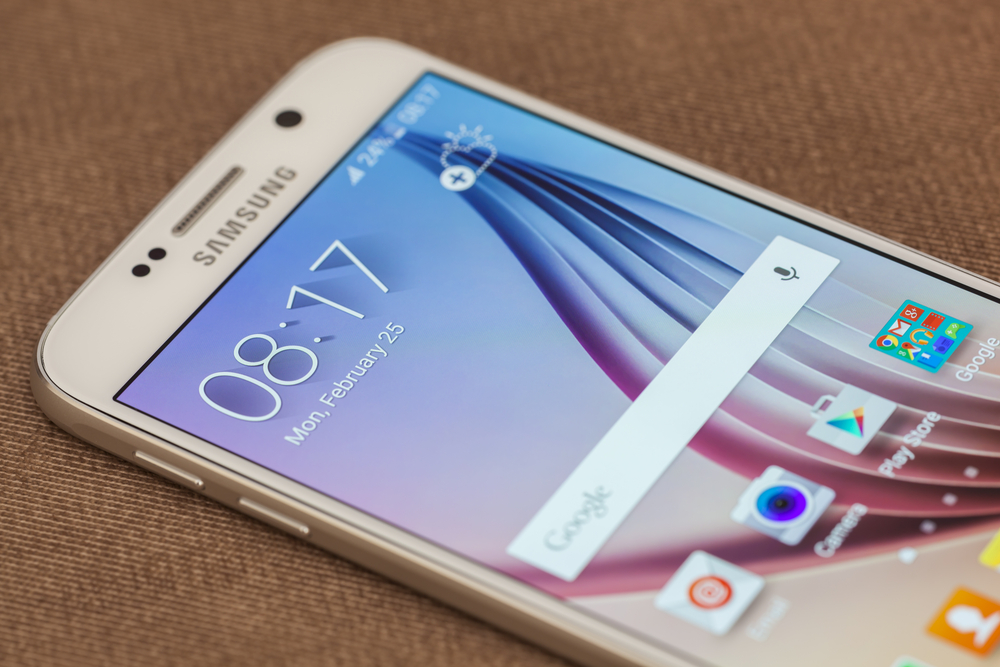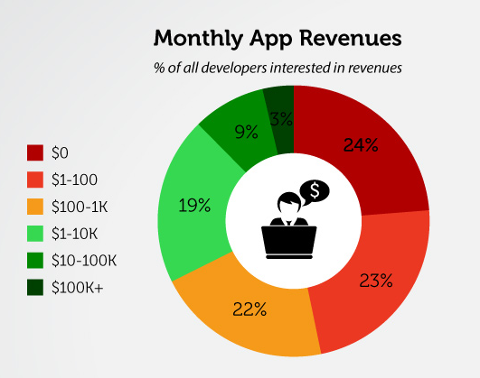 For mobile developers, the landscape remains unchanged in 2017: the app ecosystem is neatly divided between Google Android and Apple’s iOS, while competing operating systems fight for market-share scraps. According to the latest data from Flurry Analytics, some 44 percent of new mobile devices activated during the just-passed holiday season belonged to Apple. Various Android manufacturers took the rest of the pie, with Samsung easily grabbing the largest slice at 21 percent. And big phones remain, well, big. “Phablets devices (5in-6.9in) continue to eat away at medium phone (3.5in-4.9in) market share,” stated Flurry’s analysis. “Although medium phones saw the most activations during the week leading up to the holidays, Phablets continue to increase their holiday share, at the detriment of the medium phone.” After a long period of declines, Flurry added, the tablet market has stabilized somewhat, with activation activity “relatively flat year over year.” The last year was a tough one for the Android brand. Samsung faced down a PR nightmare when its flagship Note 7 devices began catching on fire, forcing a recall and a public apology. And despite the plethora of Android devices on the market, Apple’s iPhone managed to seize virtually all smartphone-market profits by the third quarter of 2016. Despite those stumbles, however, there are signs that Android will present Apple with some fierce competition in 2017. Exhibit A is Google’s Pixel smartphone, a high-end offering that attracted strong reviews from tech publications; in addition to all of its other features, the device enables Google’s Daydream VR platform, which could give the search-engine giant a significant advantage in the coming war for the mid-tier VR market. In the wake of its disaster in 2016, Samsung will almost certainly attempt to reclaim the initiative this year with new devices and features. Given its market-share and strong brand, nobody should count it out. The big question is whether the “Note” brand will ever return, or if Samsung will rename its phablet line. The tenth anniversary of the iPhone is this year, but it remains to be seen whether Apple will make a big deal of the occasion; traditionally, the firm has not spent a lot of time mythologizing its past, preferring instead to focus press and consumer attention on its newest products. Early leaks (always to be taken with the proverbial grain of salt) suggest that Apple may roll out its next iPhone model in three different sizes: 4.7, 5.5, and 5.8 inches. The design and features of the device, however, will be kept under wraps until Apple’s inevitably well-choreographed rollout. Those developers who specialize in iOS and Android apps will likely confront few game-changing surprises this year. But there’s something to be said for market stability, as it allows creators to focus more intently on making their apps great.
For mobile developers, the landscape remains unchanged in 2017: the app ecosystem is neatly divided between Google Android and Apple’s iOS, while competing operating systems fight for market-share scraps. According to the latest data from Flurry Analytics, some 44 percent of new mobile devices activated during the just-passed holiday season belonged to Apple. Various Android manufacturers took the rest of the pie, with Samsung easily grabbing the largest slice at 21 percent. And big phones remain, well, big. “Phablets devices (5in-6.9in) continue to eat away at medium phone (3.5in-4.9in) market share,” stated Flurry’s analysis. “Although medium phones saw the most activations during the week leading up to the holidays, Phablets continue to increase their holiday share, at the detriment of the medium phone.” After a long period of declines, Flurry added, the tablet market has stabilized somewhat, with activation activity “relatively flat year over year.” The last year was a tough one for the Android brand. Samsung faced down a PR nightmare when its flagship Note 7 devices began catching on fire, forcing a recall and a public apology. And despite the plethora of Android devices on the market, Apple’s iPhone managed to seize virtually all smartphone-market profits by the third quarter of 2016. Despite those stumbles, however, there are signs that Android will present Apple with some fierce competition in 2017. Exhibit A is Google’s Pixel smartphone, a high-end offering that attracted strong reviews from tech publications; in addition to all of its other features, the device enables Google’s Daydream VR platform, which could give the search-engine giant a significant advantage in the coming war for the mid-tier VR market. In the wake of its disaster in 2016, Samsung will almost certainly attempt to reclaim the initiative this year with new devices and features. Given its market-share and strong brand, nobody should count it out. The big question is whether the “Note” brand will ever return, or if Samsung will rename its phablet line. The tenth anniversary of the iPhone is this year, but it remains to be seen whether Apple will make a big deal of the occasion; traditionally, the firm has not spent a lot of time mythologizing its past, preferring instead to focus press and consumer attention on its newest products. Early leaks (always to be taken with the proverbial grain of salt) suggest that Apple may roll out its next iPhone model in three different sizes: 4.7, 5.5, and 5.8 inches. The design and features of the device, however, will be kept under wraps until Apple’s inevitably well-choreographed rollout. Those developers who specialize in iOS and Android apps will likely confront few game-changing surprises this year. But there’s something to be said for market stability, as it allows creators to focus more intently on making their apps great. Shocker: Android, iOS Dominate Mobile Landscape
 For mobile developers, the landscape remains unchanged in 2017: the app ecosystem is neatly divided between Google Android and Apple’s iOS, while competing operating systems fight for market-share scraps. According to the latest data from Flurry Analytics, some 44 percent of new mobile devices activated during the just-passed holiday season belonged to Apple. Various Android manufacturers took the rest of the pie, with Samsung easily grabbing the largest slice at 21 percent. And big phones remain, well, big. “Phablets devices (5in-6.9in) continue to eat away at medium phone (3.5in-4.9in) market share,” stated Flurry’s analysis. “Although medium phones saw the most activations during the week leading up to the holidays, Phablets continue to increase their holiday share, at the detriment of the medium phone.” After a long period of declines, Flurry added, the tablet market has stabilized somewhat, with activation activity “relatively flat year over year.” The last year was a tough one for the Android brand. Samsung faced down a PR nightmare when its flagship Note 7 devices began catching on fire, forcing a recall and a public apology. And despite the plethora of Android devices on the market, Apple’s iPhone managed to seize virtually all smartphone-market profits by the third quarter of 2016. Despite those stumbles, however, there are signs that Android will present Apple with some fierce competition in 2017. Exhibit A is Google’s Pixel smartphone, a high-end offering that attracted strong reviews from tech publications; in addition to all of its other features, the device enables Google’s Daydream VR platform, which could give the search-engine giant a significant advantage in the coming war for the mid-tier VR market. In the wake of its disaster in 2016, Samsung will almost certainly attempt to reclaim the initiative this year with new devices and features. Given its market-share and strong brand, nobody should count it out. The big question is whether the “Note” brand will ever return, or if Samsung will rename its phablet line. The tenth anniversary of the iPhone is this year, but it remains to be seen whether Apple will make a big deal of the occasion; traditionally, the firm has not spent a lot of time mythologizing its past, preferring instead to focus press and consumer attention on its newest products. Early leaks (always to be taken with the proverbial grain of salt) suggest that Apple may roll out its next iPhone model in three different sizes: 4.7, 5.5, and 5.8 inches. The design and features of the device, however, will be kept under wraps until Apple’s inevitably well-choreographed rollout. Those developers who specialize in iOS and Android apps will likely confront few game-changing surprises this year. But there’s something to be said for market stability, as it allows creators to focus more intently on making their apps great.
For mobile developers, the landscape remains unchanged in 2017: the app ecosystem is neatly divided between Google Android and Apple’s iOS, while competing operating systems fight for market-share scraps. According to the latest data from Flurry Analytics, some 44 percent of new mobile devices activated during the just-passed holiday season belonged to Apple. Various Android manufacturers took the rest of the pie, with Samsung easily grabbing the largest slice at 21 percent. And big phones remain, well, big. “Phablets devices (5in-6.9in) continue to eat away at medium phone (3.5in-4.9in) market share,” stated Flurry’s analysis. “Although medium phones saw the most activations during the week leading up to the holidays, Phablets continue to increase their holiday share, at the detriment of the medium phone.” After a long period of declines, Flurry added, the tablet market has stabilized somewhat, with activation activity “relatively flat year over year.” The last year was a tough one for the Android brand. Samsung faced down a PR nightmare when its flagship Note 7 devices began catching on fire, forcing a recall and a public apology. And despite the plethora of Android devices on the market, Apple’s iPhone managed to seize virtually all smartphone-market profits by the third quarter of 2016. Despite those stumbles, however, there are signs that Android will present Apple with some fierce competition in 2017. Exhibit A is Google’s Pixel smartphone, a high-end offering that attracted strong reviews from tech publications; in addition to all of its other features, the device enables Google’s Daydream VR platform, which could give the search-engine giant a significant advantage in the coming war for the mid-tier VR market. In the wake of its disaster in 2016, Samsung will almost certainly attempt to reclaim the initiative this year with new devices and features. Given its market-share and strong brand, nobody should count it out. The big question is whether the “Note” brand will ever return, or if Samsung will rename its phablet line. The tenth anniversary of the iPhone is this year, but it remains to be seen whether Apple will make a big deal of the occasion; traditionally, the firm has not spent a lot of time mythologizing its past, preferring instead to focus press and consumer attention on its newest products. Early leaks (always to be taken with the proverbial grain of salt) suggest that Apple may roll out its next iPhone model in three different sizes: 4.7, 5.5, and 5.8 inches. The design and features of the device, however, will be kept under wraps until Apple’s inevitably well-choreographed rollout. Those developers who specialize in iOS and Android apps will likely confront few game-changing surprises this year. But there’s something to be said for market stability, as it allows creators to focus more intently on making their apps great. 

